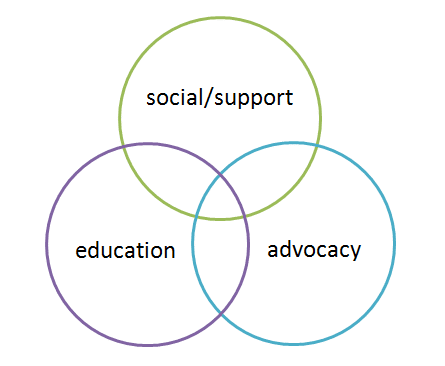Download a PDF of this version here.
The purpose of this activity is to discuss the different roles a Gay-Straight Alliance (GSA) can play and to help students identify which activities and events they may want to plan over a given timeframe. By identifying what “kind” of GSA you have, this activity can also help the group identify a mission statement for the club.
To begin: Draw the following Venn diagram on a whiteboard or large sheet of paper. Note: Some will choose to separate “social” and “support”, using four overlapping circles. Use whatever picture works best for you.
Explain that this picture is meant to represent some of the common “elements” of a Gay-Straight Alliance. While every GSA is unique, many clubs plan activities that are social, educational and/or activist in nature. It’s important to find a balance that best fits your club, so that all the members’ needs are being met. If your club only works on big advocacy events like Day of Silence, students who are simply looking for a safe space to talk about LGBT issues might be discouraged from joining the GSA. On the flipside, a club where students only talk might not be appealing to those who want to work on activities that aim to change the climate of the school.
Step 1: Have the group talk about each of these circles and the kinds of activities that might fall under the three categories. Some activities might fit into more than one category (and that’s okay!). List the activities on the whiteboard or piece of paper. Here is a sample list:
social/support: movie night, icebreaker activities, storytelling day, trust exercises, board game day, show & tell, sharing circle, charades, baking day, twenty questions, arts and crafts, slam poetry, facilitated discussions, etc.
education: bring in a speaker to talk about a topic, organize a teacher training, pick an issue and have one or two students do research and bring back to the group to discuss, watch a movie about LGBT history, create a poster/visual campaign with stats and facts about LGBT people/issues, ask your school library if you can create a display of books by known LGBT people, conduct a climate survey, participate in Black History Month events, etc.
advocacy: organize events for one of the many national days of action (Day of Silence, Ally Week, Transgender Day of Remembrance, Martin Luther King Jr. Day, World AIDS Day), create a poster campaign that encourages students not to use phrases like “that’s so gay”, work with your school to strengthen pupil nondiscrimination and harassment policies and procedures, petition your school to establish gender neutral bathrooms, hold a fundraiser, etc.
Step 2: After your list is complete, ask the students to think about what kind of activities they would like to see the GSA work on. Looking at the list you have created together, ask each student to think about his/her/hir* top four activities (they don’t have to share their top four).
Step 3: Go around the room, asking each student to list how many “types” of activities are in his/her/hir top four. For example, a student that selected movie night, board game day, organizing a teacher training, and Day of Silence would have two “social/support” activities, one “education” activity and one “advocacy” activity. Place tally marks in the appropriate circles in the Venn diagram to correspond with that student’s choices.
Step 4: After each student has shared, it will be evident from the tally marks what “kind” of GSA the students would prefer to have. If there are twenty tally marks in the social/support circle, but only a handful in the other two, then the GSA should be structured more as a group where students come to socialize and talk about issues, rather than a group that is always planning for big events.
If you haven’t already done so, this would be a good time for the group to come up with a mission statement that reflects what the students hope to get out of the club; it would also be an ideal time to forecast ahead and identify a couple of activities that the club will organize over the course of the semester or year.
Recommendations: If you find that the tally marks are fairly evenly split between the three circles, there are a number of ways you can help balance the focus while still meeting the needs of all the students in the club:
ü Create a GSA calendar for the semester to be posted somewhere that is accessible to all club members. If the club meets every week, then structure the weeks so that meetings alternate between “social days” and “planning days”.
ü If students find that meeting only every other week to plan for events is not enough, recommend that they form committees within the group. When it comes to planning big events like Day of Silence, it is often necessary to do some work outside of the regular meeting times. The use of committees can help break up the work so that it’s more manageable.
ü This Venn diagram should be revisited as time goes on and as membership in the club changes. A successful organization is one that regularly checks in with its members to discuss whether their needs and wants are being met by the current goals, focus and mission.
*Hir is a single-person gender neutral possessive pronoun. The corresponding subject pronoun is Ze. Examples: “Ze returned hir books to the library.” “Those are not my shoes, they are hirs; they belong to hir.” For more information, check out the “Pronouns Are Important” resource on the GSAFE website.
Adapted from a Jump-Start resource created by the Gay, Lesbian, Straight Education Network (GLSEN).

